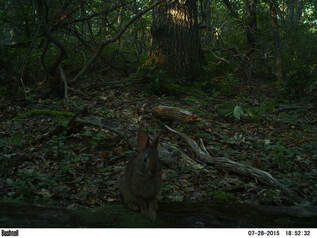
 Our project site for all things New England cottontail and young forest is now up and running! Learn more about our ongoing research with New England cottontails (aka the wood rabbit) and the young forests they, as well as many other species, rely on. You can read about our creative solutions to improve woodlands for imperiled species, the researchers working to make this happen, as well as explore different ways to get involved. Don't forget to browse some of our photos from the field!
 A New England cottontail rests on a log in a Hudson Valley forest. A New England cottontail rests on a log in a Hudson Valley forest. Many wildlife species live in patchy habitats. Animals move between patches frequently or not, but connectivity among patches is maintained and populations persist. Occasionally a bad year, disaster, or just bad luck wipes out all individuals in a patch but new individuals eventually find it, move in and the system remains stable. These systems are generally referred to as metapopulations and many species have existed in stable metapopulations for millions of years. However, today, the connections between the individual patches making up metapopulations are increasingly fragmented by roads, human development, or otherwise altered habitat. As a result, metapopulations may be fragmented into multiple, smaller parts and their individual patches may more frequently blink out and it may take longer for them to be recolonized-or they may never be recolonized. The end result is population declines as individual patches are lost but never recolonized leading to an increased susceptibility to permanent metapopulation extinction. Recent research led by Dr. Amanda Cheeseman of SUNY-ESF suggests that this scenario is occurring in even the most secure populations of New England cottontails raising concerns for the status and long term stability of populations in New York and across their range. Her work, recently published in Conservation Genetics builds off of a rich literature suggesting that populations of New England cottontails are highly susceptible to metapopulation breakdown as a result of habitat loss and poor connectivity among remnant populations. Her findings suggest that habitat loss and fragmentation by roads in New York have created a patchwork of unsustainably small populations, each displaying indicators of decreased genetic diversity. Restoring connectivity among fragmented metapopulations in an effort to increase population size to sustainable levels should be a priority for managers. A combination of habitat creation, a focus on creating wildlife corridors, and translocation and reintroduction efforts may be necessary to achieve these goals. |
Categories
All
Archives
July 2019
|
 RSS Feed
RSS Feed
